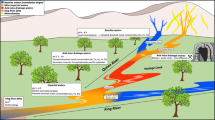Abstract
Fresh flood deposits were sampled in the flood-plains of two river systems, the River Meuse, with a catchment area of 33,000 km2 and the River Geul, with a catchment area of 3,000 km2. As a result of industrial and mining activities, both rivers have a history of severe metal pollution, especially with zinc, lead, and cadmium. The flood deposits of both rivers are heterogeneous mixtures of contaminated bottom sediments (with relatively long residence times in the river) and clean sediments derived from soil erosion on agricultural cropland (with very short residence times). An additional source of sediment is formed by erosion of older, locally highly contaminated streambank deposits. These older sediments are polluted as a result of solid waste disposal containing metalliferous ore and tailings in the sand fraction. This is especially the case in the River Geul, which drains an old zinc and lead mining area. The metal content of the Meuse sediments, however, originates largely from liquid industrial wastes and occurs mainly in the clay fraction. For this reason, the positive correlation between textural composition, organic matter content, and heavy metal concentration, which is often reported, was not observed, and normalization of the metal content was not possible. Nevertheless, a clear decrease of contamination was noticed along the River Geul; this trend was absent along the River Meuse. An attempt has been made to model the longitudinal decay pattern for each of the investigated havey metals.
Similar content being viewed by others
References Cited
Anonymous, 1983, Leidraad Bodemsanering: Ministerie van Volkshuisvesting, Ruimtelijke Ordening en Milieubeheer, Leidschendam, The Netherlands, 133 p.
Anonymous, 1985, De Maas is uit.... Ministerie van Verkeer en Waterstaat, Maastricht, The Netherlands, 38 p.
Burrough, P. A., 1986, Principles of Geographical Information Systems for Land Resources Assement: Oxford, Oxford University Press, 193 p.
de Groot, A. J., J. J. M. Goeij, and C. Zegers, 1971, Contents and behaviour of mercury as compared with other heavy metals in sediments from the Rivers Rhine and Ems, Geol. Mijnbouw, v. 50, p. 393–398.
Förstner, U., and G. T. M. Wittmann, 1983, Metal Pollution in the Aquatic Environment: Berlin, Springer-Verlag, 486 p.
Lewin, J., B. E. Davies, and P. J. Wolfenden, 1977, Interactions between channel change and historic mining sediments,in K. J. Gregory, ed., River Channel Changes: Chichester, J. Wiley and Sons, p. 353–367.
Lichtfuss, R., and G. Brümmer, 1977, Schwermetallbelastung von Elbe-Sedimenten: Naturwiss, v. 64, p. 122–125.
Oliver, M. A., and R. Wester, 1986. Semi-variograms for modelling the spatial pattern of landform and soil properties Earth. Surf. Proc. Landforms, v. 11, p. 491–504.
Perel'man, A. I., 1967, Geochemistry of Epigenesis: New York, Plenum Press, 266 p.
Rang, M. C., C. E. Kleijn, and C. J. Schouten, 1986, Historical Changes in the Enrichment of Fluvial Deposits with Heavy Metals, IAHS Publ., 157, p. 47–59.
Rashid, M. A., 1974. Adsorption of metals on sedimentary and peat humic acids: Chem. Geol., v. 13, p. 115–123.
Rose, A. W., H. E. Hawkes, and J. S. Webb, 1979, Geochemistry in Mineral Exploration: London, Academic Press, 657 p.
Salomons, W., and A. J. de Groot, 1978, Pollution history of trace metals in sediments, as affected by the Rhine River,in W. E. Krumbein, ed., Environmental Biochemistry: Ann Arbor Sci. Publ. v. 1, p. 149–162.
Salomons, W., and U. Förstner, 1984, Metals in the Hydrocycle: Berlin, Springer-Verlag, 349 p.
Smith, J. D., R. A. Nicholson, and P. J. Moore, 1973, Mercury in the sediments from the Thames estuary, Environ. Pollut., v. 4, p. 153–157.
Walkley, A., and I. A. Black, 1934. An examination of the Degtjareff method for determining soil organic matter, and a proposed modification of the chromic acid titration method: Soil Sci., v. 37: 29–38.
Webster, R., 1985, Quantitative Spatial Analysis of Soil in the Field: New York, Springer-Verlag, 69 p.
Wolfenden, P.J., and J. Lewin, 1978, Distribution of metal pollutants in active stream sediments: Catena, v. 5, p. 67–78.
Author information
Authors and Affiliations
Rights and permissions
About this article
Cite this article
Leenaers, H., Schouten, C.J. & Rang, M.C. Variability of the metal content of flood deposits. Environ. Geol. Water Sci 11, 95–106 (1988). https://doi.org/10.1007/BF02587768
Issue Date:
DOI: https://doi.org/10.1007/BF02587768




